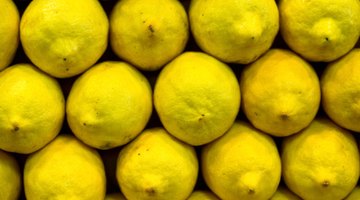How to Remove Citrus Stains
Staining your clothes, furniture or carpets with lemonade or orange juice may seem harmless enough at first. If allowed to dry, however, citrus stains become incredibly difficult to remove and can turn the fabric brittle. Previously hard-to-see stains becomes more prominent.

Things You Will Need
- Detergent
- Rags
- Vinegar
- Lemon juice
- Salt
- Enzymatic textile cleaner
With age, citrus stains harden and make the fabric hard and weak in addition to turning it yellow. Remove the stains as soon as possible after the stain occurs, but you can also address an older stain successfully.
-
Place the fabric in a sink or bathtub and pour boiling water over the stain from about 12 to 24 inches away. Repeat pouring the boiling water over the stain with the entire pot of water. If you are working with upholstery or carpet, pour the boiling water on a cloth and blot the stain with the boiling water. This works best on fresh stains, and often removes a new citrus stain in just a few pourings of the boiling water. If the stain still visible, move on to the next step.
-
Soak the fabric in a solution of hot water and detergent. Use one cap of detergent for each gallon of water and let soak for at least an hour. If you are working on upholstery or carpet, blot the stain with the water and detergent solution, allowing a bit of the solution to soak in before blotting it back up with a fresh cloth. If the stain still visible, move on to the next step.
-
Apply fresh lemon juice directly to the stain, followed by white vinegar. Let this solution soak into the fabric for at least 15 minutes. If you are working with fabric, rinse with hot water. If you are working with upholstery or carpet, soak a rag in hot water and blot the stain. Use a fresh cloth and press hard to remove the water, lemon and vinegar from the carpet. If the stain still visible, move on to the next step.
-
Apply fresh lemon directly to the stain and place salt directly on the lemon juice. Let sit for 15 minutes. Remove by rinsing, if working with fabric, or by blotting, if working with upholstery or carpet. If the stain still visible, move on to the next step.
-
Use an enzymatic cleaner made specifically for fabrics and apply according to the manufacturer’s instructions. This usually involves letting the enzyme solution sit for an extended period of time and drying in a warm room.
References
Writer Bio
Based in the Pacific Northwest, Arin Bodden started writing professionally in 2003. Her writing has been featured in "Northwest Boulevard" and "Mermaids." She received the Huston Medal in English in 2005. Bodden has a Master of Arts in English from Eastern Washington University. She currently teaches English composition and technical writing at the university level.
Photo Credits
- Jupiterimages/Photos.com/Getty Images
- Jupiterimages/Photos.com/Getty Images
More Articles



